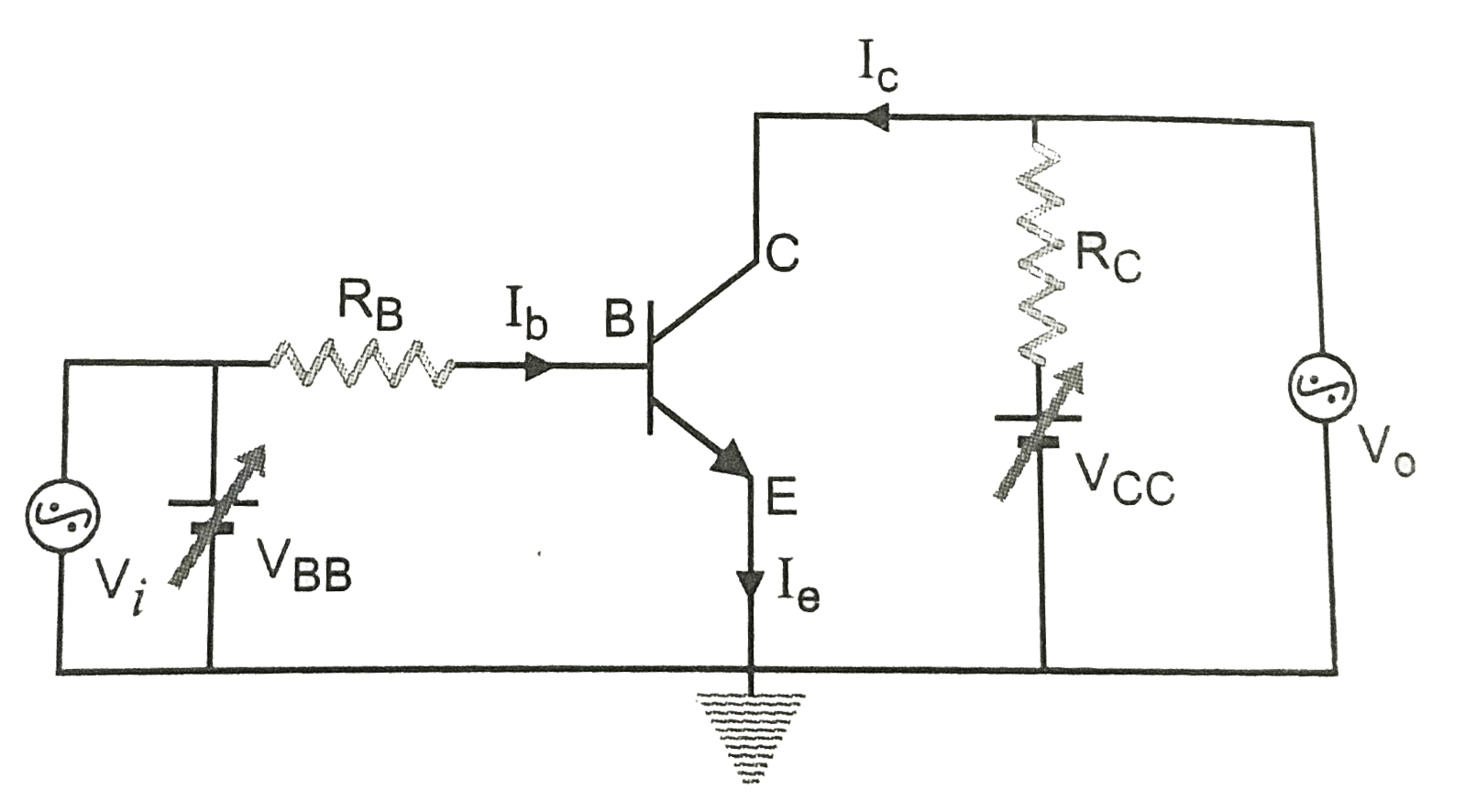A common emitted amplifier circuit, built using an npn transistor, is shown in the figure. Its dc current gain is 250,RC=1Kω and VCC=10V. What is the minimum base current for VCE to reach saturation? 
7 μA
40 μA
10 μA
100 μA
Current flowing in the circuit is as shown in diagram (given βb=250)

When saturation state is schieved then potential difference across collector and emitter (VCE
become zero .Hence collector current becomes.
ic=101000=10mA
DC current gain can be written as follows
β=icIb⇒250=10mAIb⇒(iB)=40μA
Hence option (b) is currect.
Topper's Solved these Questions
- SEMICONDUCTOR ELECTRONICS METERIALS DEVICES AND SIMPLE CIRCUITS Book:MODERN PUBLICATIONChapter:SEMICONDUCTOR ELECTRONICS METERIALS DEVICES AND SIMPLE CIRCUITS Exercise:COMPETION FILE( MULTIPLE CHOICE QUESTIONS )
Explore 17 Videos
- SEMICONDUCTOR ELECTRONICS METERIALS DEVICES AND SIMPLE CIRCUITS Book:MODERN PUBLICATIONChapter:SEMICONDUCTOR ELECTRONICS METERIALS DEVICES AND SIMPLE CIRCUITS Exercise:COMPETION FILE (ASSERTION REASON TYPE QUESTIONS )
Explore 9 Videos
- SEMICONDUCTOR ELECTRONICS METERIALS DEVICES AND SIMPLE CIRCUITS Book:MODERN PUBLICATIONChapter:SEMICONDUCTOR ELECTRONICS METERIALS DEVICES AND SIMPLE CIRCUITS Exercise:COMPETION FILE (MULTIPLE CHOICE QUESTIONS WITH ONLY ONE CORRECT ANSWER)
Explore 51 Videos
- RAY OPTICS AND OPTICAL INSTRUMENTSBook:MODERN PUBLICATIONChapter:RAY OPTICS AND OPTICAL INSTRUMENTSExercise:CHAPTER PRACTICE TEST
Explore 14 Videos
- WAVE OPTICALBook:MODERN PUBLICATIONChapter:WAVE OPTICALExercise:CHAPTER PRACTICE TEST
Explore 7 Videos
Similar Questions
Knowledge Check
In the common emitter amplifier circuit, Fig. an npn transistor with output voltage of the amplifier as 1 V, the current gain of transistor amplifier is :
 A20B25C50D75
A20B25C50D75
Output characteristic of n-p-n transistor in CE configuration is shown. From the characteristic curve determine the current gain at VCE=1V-A30B32C28D40a common emitter amplifier gives an output of 3V for an input of 0.01 V. if current gain of the transistor is 100 and the input resistance is 1kΩ. Then the collector resistance is
A30kΩB3kΩC1kΩD6kΩ
In a common base transistor circuit, IC is the Output current and IE is the input current. The current gain α is
View SolutionThe output characteristics of a transistor is shown in the figure. When VCE is 10 V and IC=4.0mA, then value of βac is _________

View SolutionIn the common emitter circuit as shown in Fig, the value of the current gain is 100. Find IB,VCE,VBE,VBC when IC=1.5mA. The transistor is in active, cutoff or saturation state.

View SolutionIn common emitter transistor as shown in Fig., the VBB supply can be varied from 0 V to 5.0V. The Si. Transistor has βac=250 and RB=100kΩ,Rc=1kΩ,VCC=5.0V. Assume that when the transistor is saturated, VCE=0V and VBE=0.8V. Calculate the minimum base current, for which the transistor will reach saturation. Hance, determine Vi when the transistor is 'switched on' find ranges of Vi for which the transistor is switched off and switched on.

View Solution
In the junction transistor voltage amplifier circuit of figure, if R1=100kΩ,R2=1kΩ,VCC=6.0V and VBE=0.6V current gain=60
View Solution
